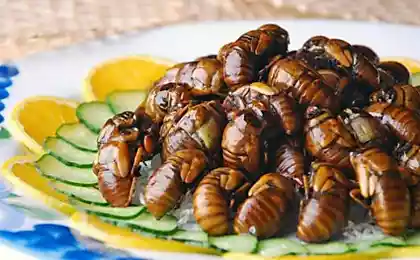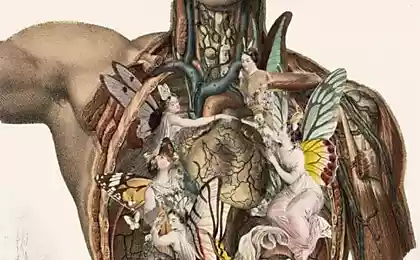2008
Eat them, and they look ...
Many futurists predict 20-30 years serious problems with food. But do not forget that about 90% of the biomass of the earth are insects. So, here are a few recipes for dinner ...)) 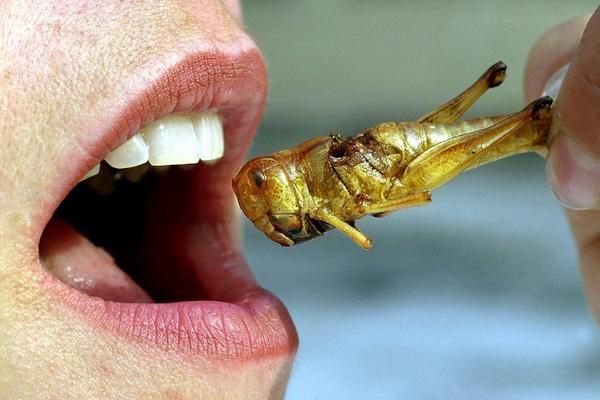
total in the world, there are 1462 species of edible insects, and it is unlikely you can try them all in a lifetime. However, thanks to the Internet, to eat a particular insect is now not have to go to Thailand, Uganda and New Guinea: companies that sell online insects, becomes more and more.
Fried bamboo chervi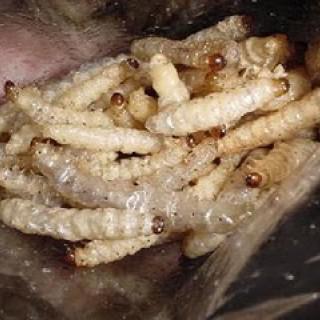
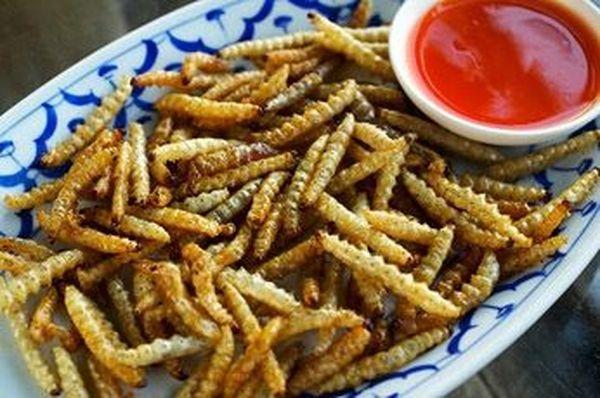
Where: Thailand, China, Latin America
For Thai dish of fried in oil bamboo worms - a traditional way to start the meal, like a salad or soup for Europeans. The taste and texture of their a bit like popcorn, although some special pronounced taste they do not have, but it is very nutritious.
In fact, this is not worms, larvae and herbal moth of the family ognevok-travyanok (Crambidae), living in bamboo. Traditionally, they are collected by cutting the bamboo stalks, but has recently started to raise commercial manner on farms and packed into bags, as chips. Bizarre Food products company can, for example, to buy in England. In addition to the Thai bamboo worms happy to eat in China and in the Amazon.
Skewers of beetle larvae-usacha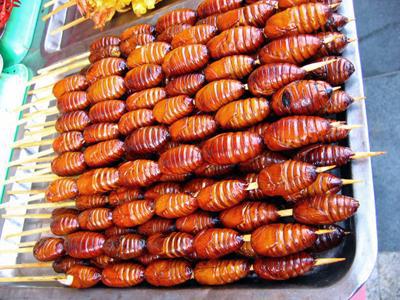
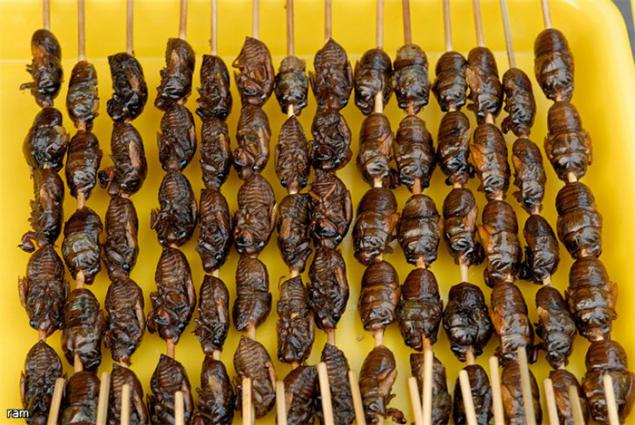
Where: Eastern Indonesia
Barbel, large and shiny beetles with long antennae, aerials, distributed throughout the world, many of them in Russia. We also called longhorn beetles in the English-speaking world - Capricorn beetle (capricorn beetle).
The larvae of longhorn beetles that live in the roots of sago palms - this is a very popular food in the village of East Indonesia. For fatty and juicy larvae Indonesians sometimes negate the small palm grove, and then neatly strung on sticks, roasted over the fire larvae. Their flesh is tender, but very thick skin that takes a long time to chew. The taste of the larvae resemble bacon fat.
The larvae eat and another application: the villagers use them as their brush ear - living larva tuck into your ear, holding the tail with your fingers, and that pretty quickly eats away the ear wax.
Cheese with cheese grubs muhi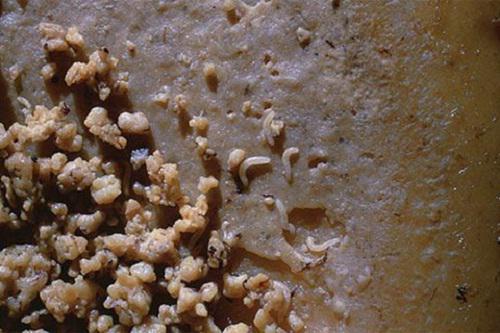

Where: Sardinia
This cheese - proof that eat insects, not only in Africa and Asia. Casu marzu - important Sardinian specialties: cheese made from unpasteurized goat's milk cheese with live larvae of flies Piophila casei. For most cheese lovers casu marzu - it's not just mature cheese or blue cheese, and finally foul cheese with worms. Strictly speaking, the way it is: it is a regular pecorino, from which the top layer is cut to the cheese fly freely put down their eggs in it. The emerging larvae begin to eat away then cheese inside - acid in their digestive system breaks down fats in the cheese and gives it a peculiar softness. Part of the liquid flows out even - it's called lágrima, which translated means "tears».
Sardinia casu marzu considered an aphrodisiac and is traditionally eaten with worms. Moreover, it is believed that there casu marzu safely only until the larvae were alive. It is not easy to do: Worried larvae reaching a centimeter in length, can jump out of the cheese to a height of 15 cm - described many cases where they enter the eye to those who tried the cheese. Therefore fans casu marzu often eat this cheese with glasses or smeared it on the bread, cover sandwich hand. However, remove the larvae from the cheese is not a crime. The easiest way - to stick a piece of cheese or a sandwich in a paper bag and tightly close it: suffocating the larvae begin to jump out. When the shooting stops in the package, the cheese can be eaten.
Of course, no hygiene standards of the European Union casu marzu does not match and has long been banned (it was only available on the black market at twice the price of conventional pecorino). But in 2010, casu marzu was recognized cultural heritage of Sardinia and again allowed.
Dried mopane caterpillars with lukom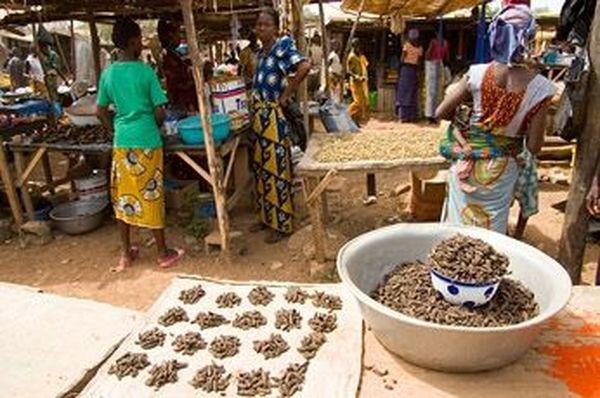
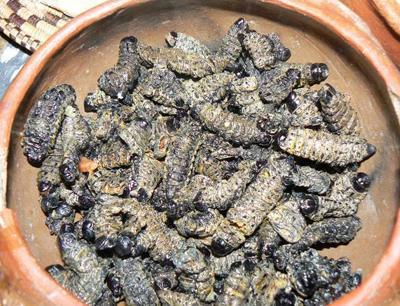
Where: South Africa
Dried caterpillar moths Gonimbrasia belina, a South African species pavlinoglazok living mopane trees - an important source of protein for the people of South Africa. Gathering these caterpillars in Africa - it is a serious business: in supermarkets and markets can be seen as dried and smoked manually and marinated, rolled in tin caterpillars.
To prepare the caterpillar must first overcome its green intestine (typically larvae simply compressed in the hand, at least - is cut along as a pea pod) and then boiled in salted water and dried. Sun-dried or smoked caterpillars are very nutritious, weigh almost nothing and stored for a long time, but do not have a special taste (often they are compared with dried tofu or even dry wood). Therefore, they are usually fried to a crisp with onion, add to soup, stew, or in different sauces served with corn porridge Saji.
However, very often mopane and eat raw, whole or, as in Botswana, severing previously head. The taste they resemble tea leaves. Collect caterpillars by hand, usually involved in these women and children. And if in the forest they belong to anyone, then collect caterpillars on neighboring trees is considered bad form. In Zimbabwe, women even mark trees with their caterpillars or young larvae are transferred closer to home, setting up a kind of plantation.
Cooked osy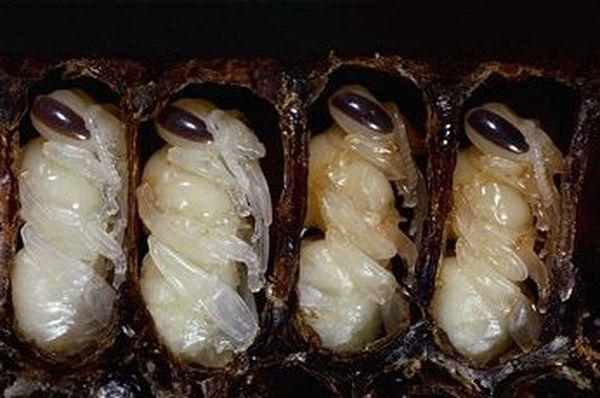
Where: Japan
The older generation of Japanese still respects the wasps and bees, cooked in many different ways. One of these dishes - hatinoko - a bee larvae, cooked with soy sauce and sugar: translucent, sweetish karamelepodobnaya mass, which goes well with rice. Just be prepared and wasps - a dish with them called dzibatinoko. Elderly Japanese dish is reminiscent of the post-war years and rationing system, when Japan wasps and bees ate particularly active. It is highly demanded in Tokyo restaurants, even as a nostalgic attraction.
In general hatinoko and dzibatinoko considered rare enough to specialize in Nagano Prefecture. Slightly more often fried black wasps: they are sometimes served with beer in Japanese taverns. Another specialty - rice crackers with earthen wasps - make the village Omata. This small cookies vlipshimi adult wasps there - each has from 5 to 15 ° C.
Japanese dishes made from wild wasps and bees, are not cheap: the flow of the business to put impossible, self cooking is quite time-consuming. Hunters wasps and bees are tied to adult individuals long colored threads and thus keep track of their nests. However, in Japanese stores can be found and preserved bees - usually so bee farm surpluses come true.
Silkworm, fried with imbirem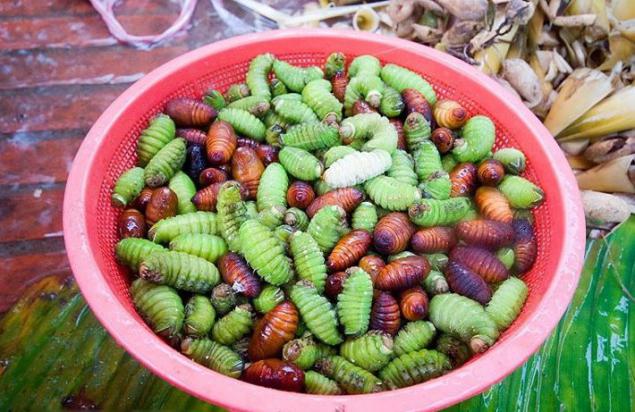
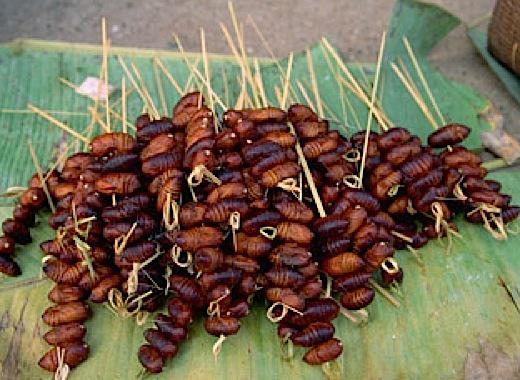
Where: China, Korea, Japan, Thailand
Suzhou City and its surroundings are known for not only quality silk, but also quite rare dishes from silkworm pupae. As you know, moth caterpillar wrapped itself thin but strong silk thread. In the cocoon they grow their wings, antennae and legs. Before this happens, the residents of Suzhou boil them, remove the cocoon, and then quickly fried in a wok - often with ginger, garlic and onion. However, the delicate larvae, crispy on the outside and soft inside, cochetayutsya successfully with virtually any vegetables and spices. Properly cooked, they resemble the taste of crab or shrimp meat.
Equally popular silkworm larvae in Korea. Trays beondegi, cooked with spices larvae or maggots for a couple, there are across the country. And in the shops sell canned silkworms, which must be boiled before use. Love them, and in Japan, especially in Nagato, and the Japanese astrophysicist Masamichi Yamashita even proposes to include in the diet of silkworm future Mars colonists.
Fried muravi
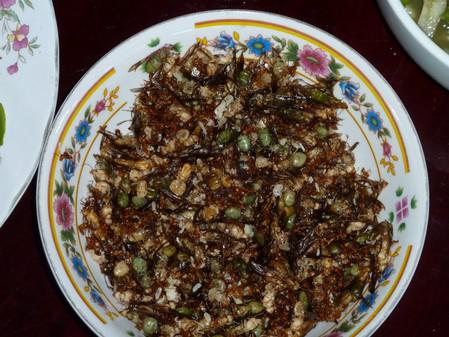
Where: Mexico, Colombia, Australia, South Africa
Ants - is the most popular edible insects in the world after the grasshoppers. In Colombia, fried ants even sell popcorn in movie theaters instead. Most females in Colombia like ants with eggs. They are caught in rainy days when the water fills the nests and females are selected out. In the simplest version of their rustic prepared, wrapped in leaves and a little hold over the fire. This crisp, sweetish appetizer with a distinct nutty flavor.
But the most delicious ants, so-called "honey", are found in Australia. They feed on the sweet nectar, transferring it to the swollen abdomen zobikah (in Russian literature, they are called "ant barrels"). These transparent bubbles are considered sweet delicacy among Australian Aborigines. In addition, two kinds of honey ants are found in South Africa and semi-deserts of North America.
Water bugs fried

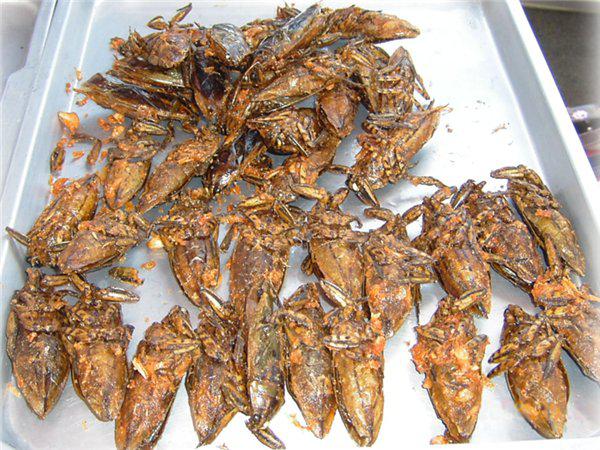
Where: Thailand, Vietnam, Philippines
Large water bugs - insects of the family Belostomatidae - live around the world, most of them in America, Canada and Southeast Asia. But if it's just for Americans, large insects, bites which do not pass sometimes two weeks, the Asian water bugs happy to eat.
Asian species, Lethocerus indicus, the largest in the family - 12 cm in length, so the Thais just fry them in deep-fried and served with plum sauce. The taste of the meat water bugs reminds shrimp. At the same time they are eaten in Thailand as a whole, the Philippines tear legs and wings (and as such serves to strong drink as a snack), and in Vietnam makes them very smelly exhaust, which is added to soups and sauces. On a bowl of soup only one drop.
Grasshoppers with avokado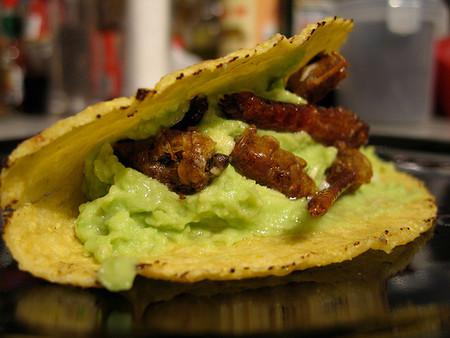
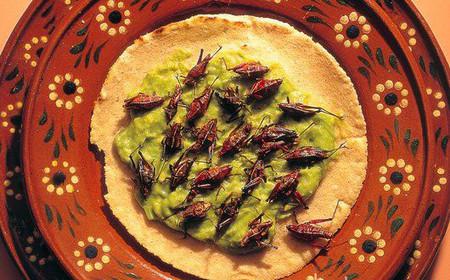
Where: Mexico
Grasshoppers, are known to feed even John the Baptist: locusts, which he seizing wild honey - it locusts, a close relative of the grasshopper. It could understand the Mexicans, for which grasshoppers - it is almost a national food. Grasshoppers eat everywhere in Mexico: boiled, raw, sun-dried, fried, soaked in lime juice. The most popular dish - guacamole with grasshoppers: fried insects quickly, causing them to instantly change color from green to red, mixed with avocado and spread on corn tortillas.
As any small insect fried, roasted grasshopper does not have outstanding flavor, and usually the taste - the taste of butter and spices in which it fried. Grasshoppers trafficked street vendors in South-East Asia - it's just refried chitin shells. In general, the grasshoppers eat wherever eat insects. Boiled in salt water and sun-dried grasshoppers eat in the Middle East, China strung them on skewers like kebabs, and in Uganda and neighboring regions - added to soups. It is curious that in Uganda until recently, women were not allowed to eat grasshoppers - I think that if they give birth to children with deformed, like grasshoppers heads.
Dragonflies in coconut moloke

Where: Bali
Dragonflies can reach speeds up to 60 km / h, so that the edible dragonfly - this is a real fast food. Catch and eat them on Bali: catch the dragonfly is not easy, this is done using sticks smeared with sticky tree sap. The main difficulty - both smooth and quick movement of the wand to touch dragonflies.
Captured large dragonflies, which previously terminated wings or fried quickly grilled or cooked in coconut milk with ginger and garlic. Of dragonflies also do something like candy, obzharivaya them in coconut oil and sprinkled with sugar.
Bedbugs chicken pashtetom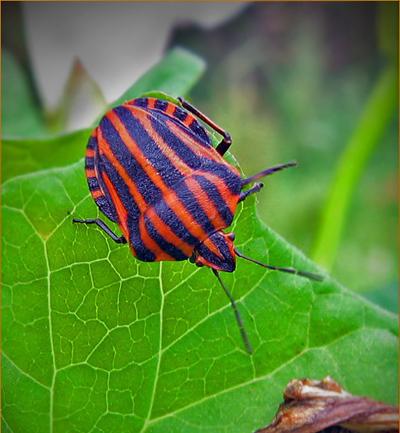

Where: Mexico
Herbal bugs - in particular, from the family Pentatomidae (Pentatomidae) - in the world also eat. Like most bugs, smelly defenders. To get rid of odors, in South Africa, their first long soak in warm water, and then dried and just bite.
In contrast, the Mexican variety of defenders just valued for their strong medical smell - probably due to the high content of iodine. American television host Andrew Zimmern, who ate defenders in an episode of the television series of his Bizarre Foods, compares them with the taste of chewing gum "Tutti frutti". In Mexico, from bedbugs make sauces, taco or added to, fry, mixed with chicken pate.
For a strong odor defenders also appreciate in Vietnam, where they are prepared spicy dish bọ xít, and Laos, where bedbugs ground into a paste cheo with spices and herbs.
Tarantulas, baked on uglyah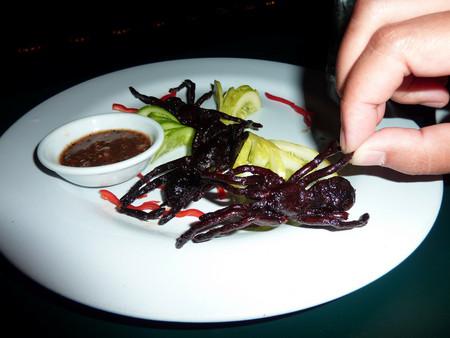
Where: Cambodia
Fried to black tarantulas, like lacquered charred embers - a common street food in Cambodia. Lucky catcher tarantulas in the day may catch up to two hundred individuals. They are sold very quickly. Cambodian tarantulas are fried in a wok with garlic and salt - to taste their meat resembles a cross between chicken and fish.
Large tarantulas, tarantulas, reaching 28 cm in diameter, eat in Venezuela, just bake them on the coals. A little more elegant way of cooking tarantulas used in Japan: there is first torn spider abdomen, then singe the hairs and quickly fried in tempura.
However, it is believed that the most delicious spiders - not tarantulas and spiders of the family Nephilidae, which is eaten in New Guinea and in Laos. The taste of these spiders if they fry resemble peanut butter.

total in the world, there are 1462 species of edible insects, and it is unlikely you can try them all in a lifetime. However, thanks to the Internet, to eat a particular insect is now not have to go to Thailand, Uganda and New Guinea: companies that sell online insects, becomes more and more.
Fried bamboo chervi


Where: Thailand, China, Latin America
For Thai dish of fried in oil bamboo worms - a traditional way to start the meal, like a salad or soup for Europeans. The taste and texture of their a bit like popcorn, although some special pronounced taste they do not have, but it is very nutritious.
In fact, this is not worms, larvae and herbal moth of the family ognevok-travyanok (Crambidae), living in bamboo. Traditionally, they are collected by cutting the bamboo stalks, but has recently started to raise commercial manner on farms and packed into bags, as chips. Bizarre Food products company can, for example, to buy in England. In addition to the Thai bamboo worms happy to eat in China and in the Amazon.
Skewers of beetle larvae-usacha


Where: Eastern Indonesia
Barbel, large and shiny beetles with long antennae, aerials, distributed throughout the world, many of them in Russia. We also called longhorn beetles in the English-speaking world - Capricorn beetle (capricorn beetle).
The larvae of longhorn beetles that live in the roots of sago palms - this is a very popular food in the village of East Indonesia. For fatty and juicy larvae Indonesians sometimes negate the small palm grove, and then neatly strung on sticks, roasted over the fire larvae. Their flesh is tender, but very thick skin that takes a long time to chew. The taste of the larvae resemble bacon fat.
The larvae eat and another application: the villagers use them as their brush ear - living larva tuck into your ear, holding the tail with your fingers, and that pretty quickly eats away the ear wax.
Cheese with cheese grubs muhi


Where: Sardinia
This cheese - proof that eat insects, not only in Africa and Asia. Casu marzu - important Sardinian specialties: cheese made from unpasteurized goat's milk cheese with live larvae of flies Piophila casei. For most cheese lovers casu marzu - it's not just mature cheese or blue cheese, and finally foul cheese with worms. Strictly speaking, the way it is: it is a regular pecorino, from which the top layer is cut to the cheese fly freely put down their eggs in it. The emerging larvae begin to eat away then cheese inside - acid in their digestive system breaks down fats in the cheese and gives it a peculiar softness. Part of the liquid flows out even - it's called lágrima, which translated means "tears».
Sardinia casu marzu considered an aphrodisiac and is traditionally eaten with worms. Moreover, it is believed that there casu marzu safely only until the larvae were alive. It is not easy to do: Worried larvae reaching a centimeter in length, can jump out of the cheese to a height of 15 cm - described many cases where they enter the eye to those who tried the cheese. Therefore fans casu marzu often eat this cheese with glasses or smeared it on the bread, cover sandwich hand. However, remove the larvae from the cheese is not a crime. The easiest way - to stick a piece of cheese or a sandwich in a paper bag and tightly close it: suffocating the larvae begin to jump out. When the shooting stops in the package, the cheese can be eaten.
Of course, no hygiene standards of the European Union casu marzu does not match and has long been banned (it was only available on the black market at twice the price of conventional pecorino). But in 2010, casu marzu was recognized cultural heritage of Sardinia and again allowed.
Dried mopane caterpillars with lukom


Where: South Africa
Dried caterpillar moths Gonimbrasia belina, a South African species pavlinoglazok living mopane trees - an important source of protein for the people of South Africa. Gathering these caterpillars in Africa - it is a serious business: in supermarkets and markets can be seen as dried and smoked manually and marinated, rolled in tin caterpillars.
To prepare the caterpillar must first overcome its green intestine (typically larvae simply compressed in the hand, at least - is cut along as a pea pod) and then boiled in salted water and dried. Sun-dried or smoked caterpillars are very nutritious, weigh almost nothing and stored for a long time, but do not have a special taste (often they are compared with dried tofu or even dry wood). Therefore, they are usually fried to a crisp with onion, add to soup, stew, or in different sauces served with corn porridge Saji.
However, very often mopane and eat raw, whole or, as in Botswana, severing previously head. The taste they resemble tea leaves. Collect caterpillars by hand, usually involved in these women and children. And if in the forest they belong to anyone, then collect caterpillars on neighboring trees is considered bad form. In Zimbabwe, women even mark trees with their caterpillars or young larvae are transferred closer to home, setting up a kind of plantation.
Cooked osy

Where: Japan
The older generation of Japanese still respects the wasps and bees, cooked in many different ways. One of these dishes - hatinoko - a bee larvae, cooked with soy sauce and sugar: translucent, sweetish karamelepodobnaya mass, which goes well with rice. Just be prepared and wasps - a dish with them called dzibatinoko. Elderly Japanese dish is reminiscent of the post-war years and rationing system, when Japan wasps and bees ate particularly active. It is highly demanded in Tokyo restaurants, even as a nostalgic attraction.
In general hatinoko and dzibatinoko considered rare enough to specialize in Nagano Prefecture. Slightly more often fried black wasps: they are sometimes served with beer in Japanese taverns. Another specialty - rice crackers with earthen wasps - make the village Omata. This small cookies vlipshimi adult wasps there - each has from 5 to 15 ° C.
Japanese dishes made from wild wasps and bees, are not cheap: the flow of the business to put impossible, self cooking is quite time-consuming. Hunters wasps and bees are tied to adult individuals long colored threads and thus keep track of their nests. However, in Japanese stores can be found and preserved bees - usually so bee farm surpluses come true.
Silkworm, fried with imbirem


Where: China, Korea, Japan, Thailand
Suzhou City and its surroundings are known for not only quality silk, but also quite rare dishes from silkworm pupae. As you know, moth caterpillar wrapped itself thin but strong silk thread. In the cocoon they grow their wings, antennae and legs. Before this happens, the residents of Suzhou boil them, remove the cocoon, and then quickly fried in a wok - often with ginger, garlic and onion. However, the delicate larvae, crispy on the outside and soft inside, cochetayutsya successfully with virtually any vegetables and spices. Properly cooked, they resemble the taste of crab or shrimp meat.
Equally popular silkworm larvae in Korea. Trays beondegi, cooked with spices larvae or maggots for a couple, there are across the country. And in the shops sell canned silkworms, which must be boiled before use. Love them, and in Japan, especially in Nagato, and the Japanese astrophysicist Masamichi Yamashita even proposes to include in the diet of silkworm future Mars colonists.
Fried muravi


Where: Mexico, Colombia, Australia, South Africa
Ants - is the most popular edible insects in the world after the grasshoppers. In Colombia, fried ants even sell popcorn in movie theaters instead. Most females in Colombia like ants with eggs. They are caught in rainy days when the water fills the nests and females are selected out. In the simplest version of their rustic prepared, wrapped in leaves and a little hold over the fire. This crisp, sweetish appetizer with a distinct nutty flavor.
But the most delicious ants, so-called "honey", are found in Australia. They feed on the sweet nectar, transferring it to the swollen abdomen zobikah (in Russian literature, they are called "ant barrels"). These transparent bubbles are considered sweet delicacy among Australian Aborigines. In addition, two kinds of honey ants are found in South Africa and semi-deserts of North America.
Water bugs fried


Where: Thailand, Vietnam, Philippines
Large water bugs - insects of the family Belostomatidae - live around the world, most of them in America, Canada and Southeast Asia. But if it's just for Americans, large insects, bites which do not pass sometimes two weeks, the Asian water bugs happy to eat.
Asian species, Lethocerus indicus, the largest in the family - 12 cm in length, so the Thais just fry them in deep-fried and served with plum sauce. The taste of the meat water bugs reminds shrimp. At the same time they are eaten in Thailand as a whole, the Philippines tear legs and wings (and as such serves to strong drink as a snack), and in Vietnam makes them very smelly exhaust, which is added to soups and sauces. On a bowl of soup only one drop.
Grasshoppers with avokado


Where: Mexico
Grasshoppers, are known to feed even John the Baptist: locusts, which he seizing wild honey - it locusts, a close relative of the grasshopper. It could understand the Mexicans, for which grasshoppers - it is almost a national food. Grasshoppers eat everywhere in Mexico: boiled, raw, sun-dried, fried, soaked in lime juice. The most popular dish - guacamole with grasshoppers: fried insects quickly, causing them to instantly change color from green to red, mixed with avocado and spread on corn tortillas.
As any small insect fried, roasted grasshopper does not have outstanding flavor, and usually the taste - the taste of butter and spices in which it fried. Grasshoppers trafficked street vendors in South-East Asia - it's just refried chitin shells. In general, the grasshoppers eat wherever eat insects. Boiled in salt water and sun-dried grasshoppers eat in the Middle East, China strung them on skewers like kebabs, and in Uganda and neighboring regions - added to soups. It is curious that in Uganda until recently, women were not allowed to eat grasshoppers - I think that if they give birth to children with deformed, like grasshoppers heads.
Dragonflies in coconut moloke


Where: Bali
Dragonflies can reach speeds up to 60 km / h, so that the edible dragonfly - this is a real fast food. Catch and eat them on Bali: catch the dragonfly is not easy, this is done using sticks smeared with sticky tree sap. The main difficulty - both smooth and quick movement of the wand to touch dragonflies.
Captured large dragonflies, which previously terminated wings or fried quickly grilled or cooked in coconut milk with ginger and garlic. Of dragonflies also do something like candy, obzharivaya them in coconut oil and sprinkled with sugar.
Bedbugs chicken pashtetom


Where: Mexico
Herbal bugs - in particular, from the family Pentatomidae (Pentatomidae) - in the world also eat. Like most bugs, smelly defenders. To get rid of odors, in South Africa, their first long soak in warm water, and then dried and just bite.
In contrast, the Mexican variety of defenders just valued for their strong medical smell - probably due to the high content of iodine. American television host Andrew Zimmern, who ate defenders in an episode of the television series of his Bizarre Foods, compares them with the taste of chewing gum "Tutti frutti". In Mexico, from bedbugs make sauces, taco or added to, fry, mixed with chicken pate.
For a strong odor defenders also appreciate in Vietnam, where they are prepared spicy dish bọ xít, and Laos, where bedbugs ground into a paste cheo with spices and herbs.
Tarantulas, baked on uglyah

Where: Cambodia
Fried to black tarantulas, like lacquered charred embers - a common street food in Cambodia. Lucky catcher tarantulas in the day may catch up to two hundred individuals. They are sold very quickly. Cambodian tarantulas are fried in a wok with garlic and salt - to taste their meat resembles a cross between chicken and fish.
Large tarantulas, tarantulas, reaching 28 cm in diameter, eat in Venezuela, just bake them on the coals. A little more elegant way of cooking tarantulas used in Japan: there is first torn spider abdomen, then singe the hairs and quickly fried in tempura.
However, it is believed that the most delicious spiders - not tarantulas and spiders of the family Nephilidae, which is eaten in New Guinea and in Laos. The taste of these spiders if they fry resemble peanut butter.







